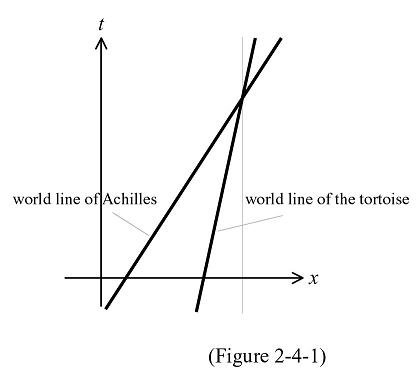A PHILOSOPHY OF THE FOUR-DIMENSIONAL SPACE-TIME
The Worldview of Relative Simultaneity (MURAYAMA Akira)
CHAPTER II The Problems of Continuity and Contradiction
4. Existence of Four-Dimensional Space-time
Next, I will address the existence of four-dimensional space-time according to the theory of relativity. In four-dimensional space-time, a moving point makes up a line called "world-line." A moving circle is a stick and a moving globe is an ultra-cylinder, which is an unimaginable kind of four-dimensional solid. An important point about this is that nothing moves here. If the world-line moves, you have to consider the concept of ultra-time, but in that scenario, there is no movement if you think about five-dimensional space-time. However, we do not need to think about more than one-dimensional time and just need to ponder four-dimensional space-time, which is a combination of three-dimensional space and one-dimensional time.
It matters a great deal whether you regard this four-dimensional space-time as just a convenient simulated conceptual structure or as an existing abstract model of the world just like three-dimensional space. If space-time is just an imaginary thing, the interpretation of Zeno's aporias based on four-dimensional space-time will hardly be convincing. In contrast, if the existence of four-dimensional space-time is as persuasive as three-dimensional space, you have to pay keen attention to the discussions below. Essentially, three-dimensional space itself is an abstract concept and in the same sense, four-dimensional space-time is also a conceptual structure. However, we actually accept three-dimensional space as an objective model in the existing world. It matters whether or not the same level of existence can be given to four-dimensional space-time. The point is whether or not four-dimensional space-time is just a graphical representation of the world invented for human convenience.
With regard to this point, I know that some people look upon four-dimensional space-time as just an imaginary conceptual model. With a focus on the relativity of simultaneity based on the theory of relativity, as noted in Chapter 1, I have reached the conclusion that the existence of four-dimensional space-time is as trustworthy as that of three-dimensional space.
In accordance with this reasoning, my argument is predicated on the assumption that the world is four-dimensionally structured. If you consider the race between Achilles and the tortoise within this framework, you will abstract them in the form of two points in space, which make up two world-lines that lean differently. The point where the two world-lines cross means the space-time point at the moment when Achilles catches up with the tortoise.

Next, let's think about a flying arrow within the same framework. The conclusion is that the world-line of the flying arrow exists in the four-dimensional space-time. It is obvious that the arrow is moving by standards except for a coordinate system with the time axis parallel to the flying arrow (that is, in the eyes of an observer who is moving at the same velocity as the flying arrow).
At least ontologically, the movement of objects can be completed without undergoing infinite processes from this viewpoint based on the existence of world-lines. All the processes from the beginning of their movement to their end exist in a determined way. There is no reason why an infinite number of creation phases have to overlap. Four-dimensional solids and world-lines in four-dimensional space-time neither appear nor vanish by themselves. All the processes of movement, emergence/disappearance, and development/decline, exist in a completed form and there is no room for wondering why an object can move. This is at least as clear as the fact that there is no room for wondering why space expands.
Furthermore, the movement of three-dimensional cross sections and each aspect of the processes of emergence/disappearance and development/decline are derived from the forms of world recognizers. This means that they need to be interpreted as the attributes of our cognitive ability, but a difficult matter is to what extent this "our" includes beyond human beings, or phenomena emerged in our thoughts. Then, it remains to be seen why those recognizers perceive the world as such representations.
I will examine this subject in the next chapter. In this context, I do highlight that the ideas behind four-dimensional space-time support the existence of moving objects without infinite dichotomy. Even if the world constitutes a discrete form like a movie in terms of time, a moving object itself is not at all affected. Movement means that something exists in a four-dimensional world with the extension of four-dimensional space-time. Being static just refers to a special representation of a four-dimensional object with a structure of its world-lines being parallel to each other in a coordinate system with the time axis parallel to the object. Being static is also a form of movement (four-dimensional existence) and is not fundamentally contradictory to movement.
Conversely, I suspect that the concept of movements in a three-dimensional world involves the pursuit of some mystic functions for the infinitesimal, for instance, force. I speculate that this worldview of movements in a three-dimensional world will never be free from Zeno's ways of thinking in some way or other.